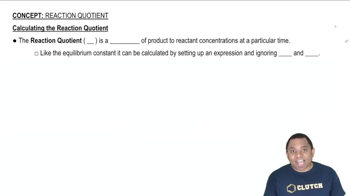For the equilibrium PH3BCl3(𝑠) ⇌ PH3(𝑔) + BCl3(𝑔) 𝐾𝑝 = 0.052 at 60°C. (b) A closed 1.500-L vessel at 60°C is charged with 0.0500 g of BCl3(𝑔); 3.00 g of solid PH3BCl3 is then added to the flask, and the system is allowed to equilibrate. What is the equilibrium concentration of PH3?
Nitric oxide (NO) reacts readily with chlorine gas as follows: 2 NO(𝑔) + Cl2(𝑔) ⇌ 2 NOCl(𝑔) At 700 K, the equilibrium constant 𝐾𝑝 for this reaction is 0.26. For each of the following mixtures at this temperature, indicate whether the mixture is at equilibrium, or, if not, whether it needs to produce more products or reactants to reach equilibrium. (b) 𝑃NO = 0.12atm, 𝑃Cl2 = 0.10atm, 𝑃NOCl = 0.050atm
 Verified step by step guidance
Verified step by step guidance
Verified video answer for a similar problem:
Key Concepts
Equilibrium Constant (Kp)

Le Chatelier's Principle

Reaction Quotient (Q)

A 0.831-g sample of SO3 is placed in a 1.00-L container and heated to 1100 K. The SO3 decomposes to SO2 and O2: 2SO3(𝑔) ⇌ 2 SO2(𝑔) + O2(𝑔) At equilibrium, the total pressure in the container is 1.300 atm. Find the values of 𝐾𝑝 and 𝐾𝑐 for this reaction at 1100 K.
At 900 °C, 𝐾𝑐 = 0.0108 for the reaction
CaCO3(𝑠) ⇌ CaO(𝑠) + CO2(𝑔)
A mixture of CaCO3, CaO, and CO2 is placed in a 10.0-L vessel at 900°C. For the following mixtures, will the amount of CaCO3 increase, decrease, or remain the same as the system approaches equilibrium?
(a) 15.0 g CaCO3, 15.0 g CaO, and 4.25 g CO2
(b) 2.50 g CaCO3, 25.0 g CaO, and 5.66 g CO2
(c) 30.5 g CaCO3, 25.5 g CaO, and 6.48 g CO2
The equilibrium constant constant 𝐾𝑐 for C(𝑠) + CO2(𝑔) ⇌ 2 CO(𝑔) is 1.9 at 1000 K and 0.133 at 298 K. (a) If excess C is allowed to react with 25.0 g of CO2 in a 3.00-L vessel at 1000 K, how many grams of CO are produced? (b) If excess C is allowed to react with 25.0 g of CO2 in a 3.00-L vessel at 1000 K, how many grams of C are consumed?
